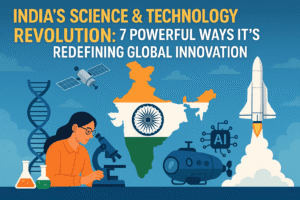India’s Science & Technology Revolution: 7 Powerful Ways It’s Redefining Global Innovation
India has decisively shifted from global science participant to pace-setter, driven by visionary policy reforms and citizen-centric innovation. Opening strategic sectors like space and nuclear power catalyzed this transformation, positioning technology as the core engine of economic growth. Tangible impacts span critical areas: indigenous triumphs like the DNA-based COVID vaccine and biotech kits bound for space missions; frontier tech like AI for disaster prediction empowering farmers via drones and satellite mapping; and ambitious projects like the deep-sea vehicle Matsya 6000.
This surge is underpinned by a thriving $165.7 billion biotech economy, over 1,750 patents, and inclusive initiatives engaging youth, women, and rural communities. Cross-sector collaboration between research, industry, and global partners fuels a vibrant startup ecosystem. India now pioneers solutions addressing its unique challenges while influencing global standards, moving decisively from borrowing best practices to beckoning the world with its model of needs-driven, sustainable innovation.

India’s Science & Technology Revolution: 7 Powerful Ways It’s Redefining Global Innovation
India’s scientific journey is no longer a story of catching up – it’s one of setting the pace. As Union Minister Dr. Jitendra Singh recently declared, the nation has shifted decisively from the periphery to the driving seat of global science and technology (S&T) innovation. This isn’t mere rhetoric; it’s a tangible transformation fueled by strategic vision and a commitment to harnessing technology as the engine of inclusive economic growth.
The Catalysts: Policy Shifts and Citizen-Centric Vision
The past decade witnessed a fundamental rewiring of India’s S&T ecosystem. Landmark decisions like opening the space and nuclear sectors to private participation weren’t just administrative changes; they were signals of a new confidence and a hunger for collaboration. Crucially, the focus sharpened on citizen-centric innovation. The guiding principle became clear: science must solve real problems for real people, from farmers in fields to astronauts in space.
From Labs to Lives: Tangible Impact Across Sectors
This shift is yielding concrete results across diverse domains:
- Biotech Powerhouse: The BioE3 Policy (Biotechnology for Economy, Environment, Employment) exemplifies this integrated approach. India isn’t just doing biotech; it’s leveraging it for holistic national progress. The development of the world’s first DNA-based COVID vaccine was a landmark, but it’s part of a broader surge – including haemophilia therapy trials and protective suits for farmers (Kisan BiokkAvch). The upcoming use of Indian biotech kits on the Axiom 4 space mission underscores the global relevance of this progress.
- Frontier Tech for Future Security: India is proactively embracing cutting-edge technologies. Artificial Intelligence isn’t just a buzzword; it’s deployed for disaster prediction, saving lives and resources. Quantum technology is being explored for securing critical communications, demonstrating a forward-looking approach to national security.
- Empowering the Agrarian Heartland: Technology is revolutionizing agriculture. Initiatives like the Soil Health Card and Swamitva Mission leverage drones, satellite mapping, and geo-tagging to empower farmers with precise information and secure land rights. The “Purple Revolution,” driven by CSIR-supported agri-startups cultivating lavender in the Himalayas, shows how science creates niche economic opportunities.
- Deep Ocean Ambitions: The upcoming sea trials of Matsya 6000, India’s indigenously developed deep-sea exploration vehicle under the Samudrayaan mission, signal a bold entry into the next frontier of exploration and resource understanding.
- Regional Responsibility: India’s scientific prowess extends beyond its borders. The Ministry of Earth Sciences sharing crucial climate and disaster forecasts with neighbouring nations exemplifies how science underpins the Neighbourhood First policy and fosters regional resilience.
Building an Inclusive Innovation Engine
Critically, this S&T surge is not confined to elite institutions. Dr. Singh emphasized a deliberate push towards inclusivity:
- Youth Engagement: Major initiatives target school students, promoting STEM careers and building a robust talent pipeline for the future.
- Women in the Lead: The rise of women-led biotech startups highlights a breaking down of traditional barriers.
- Bridging the Gap: Rural science outreach programs and mentorship platforms are actively connecting academia, industry, and society, ensuring innovations reach the grassroots and address local needs.
The New Indian Paradigm: From Borrowing to Beckoning
The statistics speak volumes: a $165.7 billion biotech economy, over 1,750 patents filed, seven vaccines developed. But the true measure lies in the shift articulated by Dr. Singh: “India is no longer borrowing best practices. We are beckoning others.”
The collaboration between research institutions (like CSIR), private enterprises, and international agencies is driving cross-border innovation. A vibrant startup ecosystem, nurtured by supportive policies and funding, is now the pulsating heart of this transformation.
The Road Ahead: Sustainability, Ethics, and Societal Need
As India prepares to host global science summits and expand R&D partnerships, the focus is crystallizing on the next chapter: sustainability-driven innovation, ethical AI frameworks, and developing homegrown technologies meticulously tailored to address India’s unique societal challenges.
India’s S&T ascent is more than a collection of achievements; it’s a fundamental reorientation. It’s a story of leveraging science not just for prestige, but for tangible progress – empowering citizens, securing the future, and offering solutions that resonate globally. The world is taking notice, not just of what India has built, but of the uniquely inclusive and needs-driven model it is pioneering. The next decade promises not just continued growth, but a defining influence on how science serves humanity.
You must be logged in to post a comment.